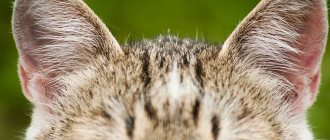Where to start breeding cats
Breeding cats is the same type of business as trade, provision of services for transporting people or goods, and many others. And before you start it, you need to decide on your goals, costs and capabilities.
The following thoughts usually push people to start this activity:
- Breeding will bring sufficient profit. Usually these are the owners of a purebred animal. Having purchased it for a sufficiently large fee, they decide to recoup the costs.
- I would like to give my cat the opportunity to give birth. Many owners mistakenly believe that the female must give birth once or twice and then she will calm down and will not demand a cat.
- Pedigree breeding will help develop a new breed or improve an existing one. Amateurs are not bothered by such problems. Those who decide to do this are most likely real professionals.
If the decision to breed cats is supported by a clearly justified goal, then it is necessary to estimate the upcoming costs.
Business plan
When figuring out how to become a cat breeder and where to start, making a business plan is a must. It will help you analyze the chosen niche and make a final conclusion. The business plan should include risks, opportunities, sales routes, competitor analysis, financial and marketing plans.
Costs and profits
At the initial stages, only approximate data can be calculated. The price for breeding purebred cats depends on the chosen breed and the number of animals. It will take approximately *1.5 million rubles to create a nursery with 10 cats. If each of them gives birth to at least 4 kittens, then you can achieve an income of *1.2 million rubles.
*Prices are current as of September 2021.
Mr. Cat Recommends: Basic Costs
It is strictly not recommended to breed cats in a city apartment. In extreme cases, it can be one couple, but even then you need a separate equipped room, at least an insulated balcony. If a pregnant and then nursing cat can be accommodated in rooms, then it is better to isolate the cat for this period.
If you have a private cottage or heated dacha, you should think about building several enclosures, for example, in warm utility rooms. And in the house itself, allocate one, two or three rooms for pregnant females and young animals.
It is necessary to ensure that the premises are sufficient in area, bright, ventilated and convenient for cleaning and disinfection. To equip one enclosure with an area of 20 square meters. m will need about 60 thousand rubles.
In addition, to maintain one breeding pair you will need to purchase the following equipment and consumables:
- Three toilet trays. It is better to buy two of them closed type (for a male cat) and one open type - for future kittens. The minimum cost is 5 thousand rubles.
- Toilet filler. For breeding animals and young animals, it is advisable to purchase wood chips; they are economical and harmless to kittens. The average monthly supply of about 30 liters is 1,500 rubles.
- Food of at least premium class for two adult animals. A supply for one month - 5 kg will cost about 4 thousand rubles. Read the article reviewing the best cat foods.
- Bowls for food and water. It is advisable to buy paired metal cups. Three sets will cost about 3 thousand rubles.
- A carrier, preferably a large one, plastic with a handle. The cost is about 3 thousand rubles.
- A house for a cat or a special complex, preferably made of carpet, complete with a scratching post. About 10 thousand rubles.
- Toys, including interactive ones, and swings. You can spend 4 thousand rubles on this.
- Tools for caring for the external appearance of animals (nail clippers, combs, massage puppies, furminators).
- Shampoos, lotions for eyes and ears, detergents and disinfectants - about 500 rubles.
- The minimum first aid kit for emergency veterinary care (at least Regidron, Vetom, Gamavit, vitamin E) is about 5 thousand rubles.
Thus, additional costs will amount to 36 thousand rubles.
The cost of one breeding pair with good quality animals can be roughly assumed to be 120 thousand rubles. Regardless of the chosen breed, this is the minimum amount.
Monthly veterinarian services can be estimated at 5 thousand rubles.
Other expenses, for example, documentation of the nursery, pedigrees, metrics for newborn kittens, taxes can also be accepted in the amount of 5 thousand rubles.
Average monthly costs and the cost of initial equipment for a cat breeding business are presented in the table. The unit of measurement is thousands of rubles.
| Number of breeding animals | 1 pair | 1 male + 2 females | 1 male + 10 females |
| Acquiring a male and female | 120 | 180 | 900 |
| Aviaries | 60 | 120 | 240 |
| Inventory and consumables | 36 | 52 | 168 |
| Veterinary services | 5 | 10 | 65 |
| Other expenses (including taxes) | 5 | 10 | 35 |
| Communal payments | 10 | 10 | 10 |
| Other unplanned expenses (increased cost of maintenance, purchase of new animals, exhibitions, treatment) | 20 | 40 | 90 |
| Keeping kittens (one litter) | 30 | 60 | 150 |
| Total: | 286 | 482 | 1658 |
| Total costs for the first year of business: | 1452 | 2484 | 7356 |
Provided that the female brings 10 kittens in a year and they can be sold at an average price of 50 thousand rubles, the investment will be recouped after one year of work (if the number of females is at least 15). The initial one-time investment is a little more than 1.658 million rubles.
If the same conditions are maintained, the second year of operation will bring a profit of 1.3 million rubles.
All calculations given are approximate. Initial conditions are always individual. In addition, it is customary to simplify many elements of the plan, but experienced breeders do not recommend saving on the arrangement and maintenance of animals, so as not to turn into a banal “breeder”.
But the most important thing to remember is that in this business you can’t get by with just counting money. Animals must be truly loved, spent time and energy on them, and constantly gain new knowledge about the peculiarities of breeding work.
General information
Finding simple income
The price tag for purebred kittens often leads to the misleading idea that getting into cat breeding is the same as starting a profitable business with low costs. Buying a cat pair is just the tip of the financial investment iceberg. There should be several cats for breeding; they all need to be adequately maintained, paid for membership in clubs and participation in exhibitions. A female can bring kittens every 3-4 months, but so that the cat does not quickly “burn out” and the offspring are healthy, it is not recommended to plan more than 2 litters per year.
Therefore, only a large nursery can count on an acceptable profit. For private breeders, cat breeding is more like a self-sustaining hobby than a stable income for a living.
We bought a cat or cat and decided to start breeding
It is not uncommon for communication with your purebred pet, its success at exhibitions and flattering comments from friends to suggest that such a beautiful animal must breed. On the one hand, show champions are regularly invited to breed, especially if they are males. Kitties often remain on the sidelines, since bearing and feeding offspring is work that not every cat owner undertakes.
On the other hand, the success of a cat at shows and his external charm sometimes does not mean at all that he can participate in replenishing the breed base. Sometimes a seemingly ideal cat has hidden genetic diseases that are revealed in the very first litters of kittens and it is obvious that it is impossible to continue breeding with this particular animal.
The cat has to give birth, it's for health
This statement is a myth generated by elementary ignorance. The cat does not have to give birth; there is even nothing wrong if she was sterilized before her first heat. Domestic cats do not pursue the goal of preserving the population, like yard and ownerless cats, because they die on the street faster than domestic cats die, which means that if they do not give birth, they will disappear as a species.
Domestic cats, and especially purebred ones, are not under threat of extinction. They don’t need to give birth “just to have it”; a one-time litter does not affect their future health in any way.
It is even recommended to castrate cats, because their regular rutting is a problem not only for the owner, but also for the animal itself, which suffers from the play of hormones.
I bred hamsters, it's time to start cats
The breeding of each animal species has a number of categorical differences from each other. Starting to breed cats, even if you have already been breeding dogs, is not at all the same thing. Moreover, the experience of breeding ferrets, hamsters, and guinea pigs in “kitten production” is completely inapplicable.
“I have repeatedly kept cats of the same breed, I have exhibition experience, I know many like-minded people and I want to contribute to the development of the breed’s studbook or develop a new hybrid”
This is how the true reason for deciding to become a breeder should be formulated. When you know the breed, have experience in keeping it, and know all the difficulties of hereditary diseases, then you can start breeding cats even at home.
Preparatory stages of breeding work
To start a business, you need to go through a number of preparatory stages:
- Register the nursery and breeding individuals in one of the felinological systems and in the local club.
- Select and reserve/purchase breeding animals. At the same time, do not forget to check all documents (pedigrees, veterinary passports, purchase and sale agreement).
- If only females are purchased, then find a worthy male (preferably two) for mating and negotiate in advance the possible prices and terms of the mating agreement.
- Prepare a platform for advertising - create a nursery website, profiles on all available social networks, register on special forums and trading platforms.
- Find out about the schedule of annual exhibitions. It is advisable to drive only a cat on them, so it is better to own one. You can also exhibit females, but usually experienced breeders do not do this, since the show animal is always under great stress. It is not worth combining it with pregnancy and childbirth. From 4 months of age, kittens can also be exhibited in shows, but this is most often done for sale. And it is the breeding cat that wins awards and enhances the reputation of the cattery.
Kittens for sale
Purebred kittens, upon reaching the age of 3 months, can already be given to new owners. Considering how quickly cats grow, advertisements are posted almost immediately after birth. The price is set solely at the request of the breeder, but in this matter it is important to rely on the average price tag of competitors, the amount of merit of the kitten’s parents, but most importantly, on the quality of the animal. If the baby meets the breed standard as closely as possible, then the price for it should be high.
Main sales routes:
- through a club - people who are looking for a purebred animal for themselves often turn to famous clubs, where they receive contacts of breeders who have recently had offspring;
- at exhibitions - at open cat exhibitions there are many visitors, they not only look at the judges’ assessment of the animals, but also often look closely at the babies brought by the owners, this path requires financial costs - it is necessary to pay for participation in the event;
- privately by advertisement - the costs and scope in this case vary greatly: from free advertisements on Internet boards to commercials on local television.
The sale of purebred kittens can be made both through personal channels and through a club
Concerned about your reputation and the future of the kids, it is recommended to enter into a cat purchase and sale agreement with the buyer. Its content implies that the new owner undertakes to:
- proper cat care;
- providing the pet with comfortable living conditions;
- monitoring the kitten's health.
Often such contracts stipulate conditions under which the breeder can take the kitten back with or without reimbursement of its cost. The conclusion of such a document is not a mandatory measure, but often it is what helps protect cats from poor living conditions and early breeding.
Advantages and disadvantages of breeding cats
The idea of organizing a cat breeding business is very popular in our country. And it has certain advantages:
- Quite a small initial investment.
- Fast business payback, good profitability.
- Any person has the opportunity to start breeding cats; according to the laws of the Russian Federation, licenses and special conditions for business are not required.
- You can operate as an individual entrepreneur or a self-supporting person, which greatly simplifies organizational arrangements. In addition, in this case, taxation is much simpler and more profitable.
- Breeding cats can be combined with your main job.
The disadvantages of this idea include:
- High competition.
- The need to learn. For business success, you need at least minimal initial knowledge, which should be constantly updated.
- Additional labor costs. Breeding cats will require not only financial investments from the nursery owner - all free time will have to be given to pets, especially when kittens are born.
- High risks. If one of the animals gets sick or dies, this will involve additional costs or a complete loss of income for the nursery.
Cattery: Legal status
Nurseries do not require state registration or licensing. To open your own nursery, you must firstly decide on the breed, secondly, get the first animals, and thirdly, join any of the existing clubs and submit an application there. Next, the club, working according to one of the international systems, will forward the application to the central office of the organization, where specialists will check the name chosen for the nursery for uniqueness, and within a week they can assign the nursery official status.
The owner does not even need to create a legal entity or register as an individual entrepreneur: in the eyes of Russian legislation, the purpose of his activities is not to make a profit on a regular basis. For this reason, legal relations with clients and taxation in this area are not regulated.
Often, nursery owners doubt whether to enter into an agreement with a client when purchasing a kitten or not, because if an agreement is concluded, they must pay personal income tax on the sale in the amount of 13%. Sometimes the owners of nurseries, when transferring kittens into the hands of new owners, draw up an agreement for the transfer of property rights or a gift agreement (tax rate - 13%), but most still prefer to do without documents.
Some factories are raising the issue of whitening their income and including nurseries in business activities. But for now this question remains open.
The most popular breeds in Moscow:
- Oriental and Siamese cats
- Scottish fold (Scottish folds)
- Canadian Sphynx
- British Shorthair
- Russian blue
- Persian cat, exotic
- Abyssinian cat
- Don Sphynx
- Kurilian Bobtail
- Siberian breed
In addition to the tax issue, nursery owners sooner or later face litigation and complaints. The initiators of the proceedings can be both suspicious neighbors and buyers of kittens. In accordance with the Civil Code of the Russian Federation, animals are property, although general rules on property apply to them with some reservations (Part 1 of Article 137 of the Civil Code of the Russian Federation). It is customary among lawyers to say that an animal is an animate thing. Therefore, the cat can be sold, donated or exchanged.
There are no documents protecting animal rights at the federal level. The only exception is Article 137 of the Civil Code of the Russian Federation: when exercising property rights in relation to an animal, cruel treatment that is contrary to the principles of humanity and Article 245 of the Criminal Code, which provides for liability for callous treatment of animals, is not allowed. But liability under this article occurs only if the animal torturer has hooligan or selfish motives, uses sadistic methods, or commits his actions in the presence of minors. Neither keeping in crowded conditions, nor savage training methods, nor other cases of inhumane treatment can be grounds for filing a complaint with the police against the torturer while the animal is alive and well. In essence, criminal liability arises for crimes against the population and public morality, and not against animal rights. When organizing a nursery and breeding animals, it is necessary to remember the Code of Administrative Offenses - Article 6.4 of the Code of Administrative Offenses provides for liability in the form of a fine for violation of sanitary and epidemiological requirements for the operation of residential premises. Sanitary and Epidemiological Supervision Standard SanPiN 2.1.2.1002-00 “Sanitary and Epidemiological Requirements for Residential Buildings and Premises”, approved by the Ministry of Health of the Russian Federation on December 15, 2000, prohibits owners and breeders from using residential premises for purposes not provided for in the design documentation; carry out actions that are a source of increased levels of noise, vibration, air pollution, or that violate the living conditions of citizens in neighboring residential premises; litter, pollute basements, stairwells and cages, attics and other common areas.
Tips for beginning breeders
There are many nuances that you should pay attention to in breeding cats.
Animal health and disabilities
When purchasing breeding animals, you should pay close attention to ensure that all individuals are healthy. To do this, you can do the necessary tests before purchasing (at the buyer’s expense).
In addition, breeding individuals should not have any birth defects. Therefore, it is worth going to the nursery with one of the experienced felinologists, if possible.
Some faults, such as medallions in color or a crease in the tail, cannot be determined when kittens are purchased. In this case, the breeder cannot be blamed for this; these are risks of acquisition.
In the future, it is necessary to carry out all measures to support the health of the entire nursery. To do this, the entire livestock should be regularly dewormed (at least once a quarter), treated for external parasites every six months, and vaccinated annually, including against rabies.
If your pets are being exhibited, you should also take care not to bring lichen into the nursery. There is no effective vaccine for it. But you can consult with a competent veterinarian and take the necessary preventive measures.
Exhibitions
Participation in exhibitions is not mandatory for breeding animals. But this will help improve the reputation of the nursery.
These activities will take up many weekends and require additional financial investment. In some felinological systems, a pet can receive high titles within a year, in others it will take a longer period (2-3 years).
Education
Often, at the beginning of their activity, young breeders undergo special training and receive a diploma as a felinologist.
This only makes sense if the breeder has decided on the breed and the teacher is competent enough.
All these courses are organized by clubs on a voluntary basis and do not have legal certificates. Rather, they can slightly contribute to the prestige of the nursery and provide some basic knowledge. Next, you need to improve your level of training on your own by communicating with experienced felinologists at exhibitions or online.
Veterinary assistance
You will have to visit a state veterinary clinic regularly, at least for annual vaccination. But sometimes unforeseen cases arise, for example, when an animal is injured or during a difficult birth.
It is advisable to find an experienced “your” veterinarian who will constantly inspect the entire nursery. Finding a competent professional in Russia is quite difficult. There are often unscrupulous doctors who are only interested in receiving monetary rewards. Not all clinics, seemingly large and well advertised, can be trusted even when undergoing banal tests.
It is better to learn some basic procedures and do them yourself, for example, trimming pets’ claws.
Details
Pros and cons of being a breeder
And so you decided that your future will be connected with a regular litter of cats. But let's go over the pros and cons of being a serious breeder.
+ Relatively small financial investments at the stage of purchasing a pair of cats or a female.
+ With the right approach, the initial investment pays off in 2-3 litters.
+ To breed cats, you do not need licenses or registration of a legal entity.
+ Registration of an individual entrepreneur or self-employed citizen is simple and makes your new business legal.
+ Breeding cats can be considered as additional income, combined with any other work.
— Among the breeds popular among buyers, there is a high competitive environment among sellers.
— Basic knowledge of felinology and zoomedicine is required.
— During the period of pregnancy by a cat and the first month of kittens, the breeder requires a lot of free time. If you work somewhere else, you may have to switch to remote work or take a vacation during this special time for your cat.
— Risks of death of offspring, complications after childbirth, or problems with conception in a particular cat.
— Earnings are not regular. There can only be one kitten in a litter, and you cannot breed a cat more than once every six months.
— Matings and litters must have registration and medical support, otherwise it will not be possible to sell kittens at high prices. At the same time, take into account the risk that not all kittens in the litter will be show class.
Selecting a breed and preparing parents
If you come to the conclusion that cat breeding is exactly what you have been missing in your life, and you have a pet with show titles, then start by finding a suitable match for him. It is easier for cat owners to participate in breeding, since they can build a career for their pet as an inseminator by charging a fee for mating with another breeder's cat. The profit here will really be maximum, because the cost of the cat was already included in your regular expenses. And the more exhibition awards and reputation of the male, the higher the cost of mating.
If you are the owner of a cat or are planning to purchase a female for further reproduction, then not only titles are important, but also the age and health of the animal.
A cat for breeding must only come from a cattery. Private sellers are not the best places to purchase a quality female. Visit shows, look out for cats with better grades, and talk to their owners. Rest assured, you will eventually be able to find direct contacts from breeders and nurseries with a reputation and guarantees.
When you decide on a breed and a nursery, when concluding an agreement to purchase an animal, always pay attention to a very important mark - whether the animal is intended for further breeding. Even if you are not asked to castrate a female cat, and the contract states that it is unsuitable for breeding, then you will not be able to cheat and breed a cat officially. Yes, you will be able to sell kittens from matings with equally irresponsible owners in search of profit, but the kittens from your matings will be “unofficial.” Pedigree, exhibitions and official matings will be prohibited for such pets. Kittens can only be sold at bird markets and private message boards. There can be no talk of any kind of business as a professional nursery.
IMPORTANT: for the future cat-parent, not only the official pedigree is important, but also membership in the club, as well as registration in the world's major felinological systems (TICA, CFA, WCF).
The next step after purchasing a suitable pet is show potential. The earliest age when it makes sense to take a kitten to an exhibition for awards is 8 months. An earlier date will not be considered. Only dogs have the “baby” category; cats do not receive children’s titles.
First grades are very important. Any cat breeding specialist will tell you that it is not enough to have a pedigree and permission to participate in matings; you need to confirm the cat’s status at exhibitions regularly. For a cat, the assessment for further matings should begin with “excellent”, and for a cat a “champion” is needed.
INTERESTING: in the USA, all cats that have a breeding certificate and have received exhibition status that meets breed standards receive final approval for breeding.
In parallel with the preparatory process for future parents, the newest breeder should take courses in cat physiology and basic knowledge of veterinary medicine. In large cities, it is not difficult to find such courses; they are held by clubs and some universities at the departments of zoology. In smaller cities, the issue can be resolved through online learning. Depending on the content of the program, the courses cost from 1,500 to 5,000 rubles. As a result, you must be issued a certificate or diploma after exams and tests.
Preparing your home for breeding cats
Cats cannot be bred on laps. Your apartment or house must have conditions for a comfortable stay for a pregnant cat and her kittens until they are transferred to a new family and the postpartum recovery period for the mother. It is especially important to organize the space if you plan to keep more than one animal at once.
IMPORTANT: you cannot breed cats and have small children in the same house. Or you should separate these two camps so much that the baby does not disturb the cats, does not irritate the kittens and does not interfere with the recovery of the pets.
If you are keeping a couple, then organizing the space is not difficult. The cat can continue to live as he lived, but the cat will need additional space for pregnancy, childbirth and raising offspring. Ideally, at normal times the couple will sleep on their usual beds, and during special periods the cat will move into a room with a “maternity” corner. A master bedroom or a separate quiet room would be ideal.
For mom, add an extra bed with a canopy. It should be larger than usual, because a pregnant cat and a cat with litter takes up a lot of space. The bed may have an extra bowl of water and some kibble for a late-night snack. The privacy of the place is checked even before giving birth; the female herself must come there for greater privacy and relaxation.
Do not allow the cat to occupy this place; the cat must have a clear understanding that this nest is only for her and there is no need to fear for her offspring.
But if you are going to keep a mini-nursery, then most likely you will have to sacrifice one of the rooms for individual enclosures and special nesting enclosures for females who are about to give birth or raise kittens.
Cats can spend the night in multi-level enclosures; females in heat, but who should not yet mate according to plan, and mating cats can be moved there. Enclosures should have beds on shelves, ladders, trays, and feeders. They should be well ventilated, individual and heated. It will not be possible to evict the entire pride into a garage; cats should only be bred in conditions that are comfortable for them.
Mating and rearing litter
After preparing the house and receiving the title as a grown cat, you can begin breeding and expecting kittens.
IMPORTANT: the first mating in cats is permissible after the first two empty heats. Cats are usually bred from 14 months, unless a different period is provided for by the characteristics of the breed.
Steps to knitting:
- Finding a partner, or using your own pair.
- Collection of documents: preliminary contract for mating, collection of tests for infections.
- Obtaining permission from a club or breed association to carry out mating.
- Meeting of partners for mating.
As you can see, conscientious cat owners do not have any particular difficulties with properly organized mating. Everything becomes a formality and clarifying bureaucracy if the cat and kitty were consciously prepared by the owners for breeding.
After mating, caring for the cat does not change, but the expectant mother needs peace. This is your opportunity to introduce her to a new place of solitude where she would like to spend a few days. Also make sure that the cat does not jump or play very actively. Embryos need rest in the earliest stages of pregnancy. Afterwards, the cat can, if desired, return to its previous bed, but the kittens growing inside will still reduce its activity.
On days 30-35, the expectant mother is moved back into the nest. Usually cats do not resist, as they already feel the need for privacy and more peace.
Before birth, cover the floor around the nest and the nest with disposable hygienic absorbent diapers, which can be easily removed after birth and leave the babies and mother clean. Also prepare a thin, but not see-through curtain for the nest, since immediately after giving birth the cat will need maximum privacy and rest. As soon as the mother recovers with her offspring, she will begin to go out to eat at her usual bowls, but for the first days it is better to organize a low enclosure around the nest, where to place food, water and a tray with diapers. Low sides will allow the offspring to crawl around the territory, but not crawl around the apartment. The mother cat can easily jump out of the enclosure. It can be removed after 4 weeks, when the kittens are no longer completely helpless and understand that they need to call their mother if they lose their way to the nest.
Don't forget to check how the cat cares for the litter. This is especially important during the first birth. Do the kittens eat enough, does she lick them well, and is there stool? Don’t let the cat near its offspring; male cats are not very good fathers and a careless male can harm the fragile little ones.
IMPORTANT: Do not allow children near the tiny kittens. You can look at the litter after 4-5 weeks, but children are generally not recommended to handle the babies. Delay first contacts until 3 months.
In the period from 4 to 9 weeks, the cat will actively teach the kittens household norms: master the litter box, go to feeding bowls, explore the territory and learn to interact with people.
Between 2-3 months, you can show kittens to future owners, sign contracts for the transfer of the animal and prepare with a veterinarian according to the standard schedule for accompanying kittens by breeders.
At 3-4 months, kittens can be given away.
Choosing a breed for breeding
Standardly and most often, the following breeds are selected with the average market value of kittens (in rubles):
- British or Scottish fold - 5,000-40,000.
British cats
- Canadian Sphynx - 15,000-75,000.
- Siamese - 15,000-100,000.
- Russian Blue - 10,000-70,000.
- Maine Coon - about 40,000.
- Persian - 5,000-80,000.
These breeds are quite easy to breed, but they are also very widespread, which is why the cost of kittens is low.
It is more profitable to deal with expensive breeds - Savannah, Caraquet, Chausie, Snow Shoe, Exotic Shorthair, Bengal, Toyger. But this will require more investment, special knowledge and labor.
Caraquet
When choosing a breed, you should also remember about the character of the pets. For example, active cats (Siamese, Bengal, Toyger) will need a large area. Others (the same Siamese or Abyssinian) are very talkative and do not shut up for a minute. Exclusive hybrid cats are quite capricious, have a wild character and are difficult to tame.
Pitfalls when breeding animals
In pursuit of profit, you will have to work hard. Animal breeders are forced to devote all their time to them, and the more cats you have, the less time you have for everything else. When starting your business, you will have to invest a lot. For example, a purebred Maine Coon will cost 20 thousand rubles and more , it depends on the specific nursery and the prospects of the kitten itself. Breeders usually sell at a higher price for breeding. Here, of course, you can cheat and say that you are taking a cat for the family, but in any case you will need a pedigree and permission to breed if you want the kittens to sell at a high price.
Matings
If there is one male and several cats in the nursery, then the breeding process must be regulated.
You should not breed a female until she reaches 12-18 months of age, only after 1-2 first heats.
If a cat is invited from the outside, then the mating agreement, which stipulates all the terms of the deal, is important. Most often, it is concluded on the basis of advance payment in cash. But if the owner of the male liked one of the cats in the nursery, and he sees an opportunity to get interesting offspring, then the contract reflects “payment by the kitten of the first choice.” This means that the second party will choose the baby from the litter that interests him most, and he has the primary right to this.
Read about mating cats and female cats.
Choosing a future manufacturer
Keep in mind that prices for pet, breed and show class kittens may vary. There is no need to try to save money by buying a cat “for the sofa” and then letting him breed. First of all, it's not decent. The breeder will be unhappy. Secondly, “for the sofa”, even with a pedigree, they often sell not the best representatives of the breed. Perhaps the animal has hidden defects. So look for a cat of at least “breed” class, and a cat of “show” class. The requirements for stud cats are stricter than for cats.
If you have already spent a little time among breeders, then you have probably found a suitable nursery that sells quality kittens. A kitten will be able to move to a new home only after reaching a certain age and having been vaccinated. But you can reserve the baby you like by paying a deposit. And be sure to conclude a purchase and sale agreement.
The kitten comes with:
- veterinary passport with a note on the vaccinations done (it is better if there are two records. If there is only one, you will have to take care of the second vaccination yourself);
- metric or pedigree, if the breeder has already obtained it on his own. If there is only a metric, the pedigree is issued by the club in which the litter was registered. Attention! Pedigree and permission to breed are two different things. The pedigree only confirms the origin of a kitten from parents of a certain breed, but not its breeding value;
- recommendations from the breeder on feeding, training, the best choice of doctor, etc. If possible, ask for them to be provided to you in writing. It is very easy to forget something important, and it will be easier for you later.
If you want to feed your kitten natural products rather than ready-made food, you will need special vitamin and mineral complexes that are added to the cat's food. They maintain the activity and resistance of the animal’s body to viruses, and normalize the balance of vitamins in the body. For example, the Radostin vitamin and mineral complex, produced in 5 types, can be used for additional care for a pet of any breed and age.
Pregnancy, childbirth, offspring
After the cats are bred, it is advisable to place them in a separate room and provide adequate nutrition and comfort. It is necessary to remove high play sets and furniture to eliminate the possibility of injury and miscarriages.
We recommend reading the article on how to tell if your cat is pregnant.
30-35 days after mating, it is better to prepare a “nest” for each female. This could be a large cardboard box, completely closed with a hole cut out, or a cat house.
Some breeds require complete privacy, such as the Bengal. If it is not possible to allocate a separate enclosure for each female, you can purchase several large metal dog cages and install the “nest” inside them, as well as a litter tray, water and food.
Immediately after giving birth, the cat is closed and the cage is covered with a blanket. In this case, the female behaves calmly and takes full care of the kittens.
If the birth proceeds normally, then it does not require intervention. But for the first birth of kittens, you can agree in advance with the veterinarian at least about 24-hour telephone consultations.
Read about a cat's first birth.
When nursing offspring, you need to carefully monitor that the cat behaves correctly, all the babies are suckling, they are licked and gaining weight.
If something in the behavior of a nursing mother or kittens causes concern, it is better to consult an experienced breeder or veterinarian.
After a month of life, kittens need to be gradually accustomed to food (it is better to start with natural meat, not dry meat), a litter tray and a scratching post. Taking them away from their mother for up to two and sometimes four months is unacceptable. Read how to accustom a kitten to a scratching post and dry food.
Cat care
As in any production, in the cat business it is necessary to take care of its “production capacity”, that is, the cats themselves. The most important thing is their health. This takes effort, time, and money. To care for cats you will need:
- Vaccination . In the first year of life, pets need to be vaccinated 3 times. They are vaccinated against panleukopenia, calicivirus and rhinotrichitis, and some vaccines also include chlamydia. The first vaccination is carried out at the age of 2-3 months, the second - 21-28 days after the first. The third vaccine is administered to a one-year-old pet. On average, a 3-component vaccine for cats costs from $7.
- Nutrition . It must be full-fledged, that is, so that the coat shines and shines, the teeth are healthy, and the claws are strong. Most often, breeders use ready-made food from specialized stores. And you shouldn't save money here. Expensive foods differ from cheap ones not only in price, but also in the fact that they have a fairly balanced vitamin and mineral composition, which has a good effect on reproductive function. Pets need to be fed 2 times a day. Optimal food portions are 100-150 g.
According to the consistency of the food, there are dry and wet. It is better if both are present in cat food. In addition to ready-made food, veterinarians advise introducing cereals, cottage cheese, and vegetables into food.
- Drinking . Fresh water must be available, so it must be changed several times a day. It is necessary to teach cats to drink water from a young age, since often adult animals do not drink it, although they lack fluid. Diseases can develop due to dehydration.
- Hygiene . Hygienic care includes grooming (bathing, combing, eliminating tangles), trimming and sharpening nails using special devices, and using anti-parasite products - worms, fleas, ticks. Of course, it is necessary to provide care for the ears, eyes and teeth. As for changing toilet filler, this should be done once every 48 hours, although this should be based on the quality of the filler (sometimes you need to change it more often).
Kittens should be regularly shown to a veterinarian, and it is advisable that he be a “family cat doctor.”
Sales and pricing
In order to make a profit, kittens must be sold.
To do this, use all possible means:
- The nursery’s own website and social networks. They need to be promoted online using numerous modern information tools.
- Forums. Most often, this site is occupied by several “star” breeders who sell kittens at high prices. It is very difficult and unpleasant to compete with them.
- Interactive trading platforms. In our country today there is practically one monopolist - Avito. There are actually no free ads there. You can try others, for example, Yulu, but so far their ratings among buyers are low.
- Exhibitions. This is a good tool for selling litter. But for a serious show, an application for participation must be submitted at least two months in advance, that is, planned in advance. Babies from 4 months are allowed to participate, very rarely from 3. In addition, funds must be spent on paying for space and participation, obtaining medical clearance to the exhibition, and no one can guarantee sales. But, as a rule, at large shows, such as the Royal Canin Grand Prix or the Commonwealth (Moscow), there are always a lot of potential and actual clients.
To determine the price of kittens, you need to study special literature and the websites of experienced breeders, and follow publications on the Internet. If there are competent, friendly felinologists in the club, then consult with them more often and listen to their recommendations.
Step-by-step list of actions for breeding purebred cats
Thus, after you decide to start breeding cats, the general plan of action will be summarized in the following points:
- choose and purchase a purebred kitten (according to previously studied literature);
- check the availability of relevant documents (passport, pedigree, etc.);
- undergo a thorough veterinary examination and receive all necessary vaccinations (if they are not available);
- join a club or system, that is, obtain the status of a breeder;
- start an exhibition career, which is necessary for admission to breeding;
- take a felinologist course;
- give competent advertising: both paid (with all photographs and text through newspapers, websites, etc.) and free (through neighbors, acquaintances and other people) to your pet;
- organize mating for the animal and then properly raise the resulting offspring (kittens);
- sell, in accordance with all the above nuances in this business, raised kittens (who have reached the age of approximately 3-4 months).
https://youtu.be/ydKA13ip7Jg
How and where to buy kittens
Animals are purchased only from time-tested and reputable breeders. If a person has a certain set of awards from exhibitions, all the documents and veterinary passports for animals, then this will be a huge plus.
Before purchasing animals, they must be carefully checked for diseases and external defects. They must fully comply with the standards and parameters of the breed. A certain level of composure is required in this matter. A kitten can be very beautiful, but not meet any of the criteria. A compassionate person will immediately take it at a loss.
Important! It is optimal to adopt cats from 3 to 6 months, when they become quite independent and weaned off their mother’s feeding, but still have enough time to get used to their new owner.
It is important to properly wean the kitten from its mother











